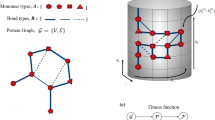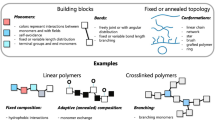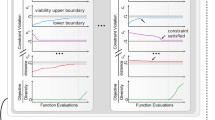Abstract
Optimization of molecular design in cellular metabolism is a necessary condition for guaranteeing a good structure-function relationship. We have studied this feature in the design of glycogen by means of the mathematical model previously presented that describes glycogen structure and its optimization function [Meléndez-Hevia et al. (1993), Biochem J 295: 477–483]. Our results demonstrate that the structure of cellular glycogen is in good agreement with these principles. Because the stored glucose in glycogen must be ready to be used at any phase of its synthesis or degradation, the full optimization of glycogen structure must also imply the optimization of every intermediate stage in its formation. This case can be viewed as a molecular instance of the eye problem, a classical paradigm of natural selection which states that every step in the evolutionary formation of a functional structure must be functional. The glycogen molecule has a highly optimized structure for its metabolic function, but the optimization of the full molecule has meaning and can be understood only by taking into account the optimization of each intermediate stage in its formation.
Similar content being viewed by others
References
Abdel-Akher M, Smith F (1951) The repeating unit of glycogen. J Am Chem Soc 73: 994–996
Alonso MD, Lomako J, Lomako WM, Whelan WJ (1995) A new look at the biogenesis of glycogen. FASEB J 9: 1126–1137
Baldwin E, Bell DJ (1940) The glycogen of Helix pomatia. Biochem J 34: 139–143
Barry C, Gavard R, Milhaud G, Aubert JP (1953) Etude du glycogène extrait de Bacillus megatherium. Ann Inst Pasteur 84: 605–613
Bathgate GN, Manners DJ (1966) Multiple branching in glycogens. Biochem J 101: 3c-5c
Bell DJ (1944) Analysis of mixtures of 2:3:4:6-Tetramethyl glucose with 2:3:6-trimethyl and dimethyl glucoses by partition on a silica-water column: a small-scale method for investigating the structures of glucopolysaccharides. J Chem Soc 473–476
Bell DJ, Manners DJ (1952) Action of crystalline β-amylase on some glycogens. J Chem Soc 3641–3645
Blows JMH, Calder PC, Geddes R, Willis PR (1988) The structure of placental glycogen. Placenta 9: 493–500
Boyer C, Preiss J (1977) Biosynthesis of bacterial glycogen. Purification and properties of the Escherichia coli B α-1,4-glucan:α-1,4-glucan 6-glycosyl transferase. Biochemistry 16: 3693–3699
Brown BI, Brown DH (1966) α-1,4-Glucan 6-glycosyltransferase from mammalian muscle. Methods Enzymol 8: 395–403
Bullivant HM, Geddes R, Willis PR (1983) The fine structure of glycogen. Biochem Int 6: 497–506
Calder PC (1987) The structure and metabolism of mammalian glycogens. Ph.D. Thesis, University of Auckland, New Zealand
Calder PC (1991) Glycogen structure and biogenesis. Int J Biochem 23: 1335–1352
Calder PC, Geddes R (1985) The proteoglycan nature of mammalian muscle glycogen. Glycoconjugate J 2: 365–373
Calder PC, Geddes R (1986) Digestion of the protein associated with muscle and liver glycogens. Carbohydr Res 148: 173–177
Camici M, DePaoli-Roach AA, Roach PJ (1984) Rabbit liver glycogen synthase. Purification and comparison of the properties of glucose 6-P dependent and glucose 6-P independent forms of the enzyme. J Biol Chem 259: 3429–3434
Caudwell FB, Cohen P (1980) Purification and subunit structure of glycogen-branching enzyme from rabbit muscle. Eur J Biochem 109: 391–394
Darwin CR (1859) On the origin of the species by means of natural selection, or the preservation of favoured races in the struggle for life. John Murray, London. Facsimile reprint of the first edition. Harvard University Press, Boston, Mass
Dawkins R (1986) The blind watchmaker. Penguin, London
Dawkins R (1994) The eye in a twinkling. Nature 368: 690–691
Dobzhansky Th (1973) Nothing in Biology makes sense except in the light of evolution. Amer Biol Teacher 35: 125–129
Farkas I, Hardy TA, Goeb MG, Roach PJ (1991) Two glycogen synthase isoforms in Saccharomyces cerevisiae are coded by distinct genes that are differentially controlled. J Biol Chem 266: 15602–15607
Gilman A, Ross J (1995) Genetic-algorythm selection of a regulatory structure that directs flux in a simple metabolic model. Biophys J 69: 1321–1333
Golden S, Wals PA, Katz J (1977) An improved procedure for the assay of glycogen synthase and phosphorylase in rat liver homogenates. Anal Biochem 77: 436–445
Goldsmith E, Sprang S, Fletterick R (1982) Structure of maltoheptaose by difference fourier methods and a model for glycogen. J Mol Biol 156: 411–427
Greenwood CT, Manners DJ (1957) The alkali-stability and molecular size of glycogens. Proc Chem Soc 26–27
Gunja-Smith Z, Marshall JJ, Mercier C, Smith EE, Whelan WJ (1970) A revision of the Meyer-Bernfeld model of glycogen and amylopectin. FEBS Lett 12: 101–104
Gunja-Smith Z, Marshall JJ, Smith EE (1971) Enzymatic determination of the unit chain length of glycogen and related polysaccharides. FEBS Lett 13: 309–311
Harrap BS, Manners DJ (1952) Molecular weight of glycogens determined by light-scattering methods. Nature 170: 419–420
Hassid WZ, Chaikoff IL (1938) The molecular structure of liver glycogen of the dog. J Biol Chem 123: 755–759
Haworth WN, Hirst EL, Smith F (1939) Polysaccharides. Part XXXVIII. The constitution of glycogen from fish liver and fish mussel. J Chem Soc 1914–1922
Heinrich R, Holzhütter HG, Schuster S (1987) A theoretical approach to the evolution and structural design of enzymatic networks: linear enzymatic chains, branched pathways and glycolysis of erythrocytes. Bull Math Biol 49: 539–595
Heinrich R, Hoffmann E (1991) Kinetic parameters of enzymatic reactions in states of maximal activity: an evolutionary approach. J Theor Biol 151: 249–283
Heinrich R, Schuster S, Holzhütter HG (1991) Mathematical analysis of enzyme reaction systems using optimization principles. Eur J Biochem 201: 1–21
Heinrich R, Montera F, Klipp E, Waddell TG, Meléndez-Hevia E (1997) Theoretical approaches to the evolutionary optimization of glycolysis. Kinetic and thermodynamic constraints. Eur J Biochem 243: 191–201
Hue L, Bontemps F, Hers HG (1975) The effect of glucose and of potassium ions on the interconversion of the two forms of glycogen phosphorylase and of glycogen synthetase in isolated rat liver preparations. Biochem J 152: 105–114
Illingworth B, Larner J, Cori GT (1952) Structure of glycogens and amylopectins. I, Enzymatic determination of chain length. J Biol Chem 199: 631–640
Kjolberg O, Manners DJ, Wright A (1963) α-1,4-Glucosans. XVII, The molecular structure of some glycogens. Comp Biochem Physiol 8: 353–365
Krisman CR (1962) α-1,4-Glucan: α-1,4-glucan 6-glycosyltransferase from liver. Biochim Biophys Acta 65: 307–315
Larner J (1955) Branching enzyme from liver. Methods Enzymol1: 222–225
Liddle AM, Manners DJ (1957) α-1,4-Glucosans. VIII Multiplebranching in glycogen and amylopectin. J Chem Soc 4708–4711
Lomako J, Lomako WM, Whelan WJ (1991) Proglycogen: a lowmolecular-weight form of muscle glycogen. FEBS Lett 279: 223–228
Lomako J, Lomako WM, Whelan WJ, Dombro RS, Neary JT, Norenberg MD (1993) Glycogen synthesis in the astrocyte: from glycogenin to proglycogen to glycogen. FASEB J 7: 1386–1393
Lupiáñez JA, García-Salgero L, Torres NV, Peragón J, Meléndez-Hevia E (1996) Metabolic support of the flight promptness of birds. Comp Biochem Physiol 113B: 439–443
Madsen NB, Cori CF (1958) The binding of glycogen and phosphorylase. J Biol Chem 233: 1251–1254
Manners DJ (1957) The molecular structure of glycogens. Adv Carbohydrate Chem 12: 261–298
Manners DJ, Maung K (1955)α-1,4-Glucosans. III, Molecular structure of brewer’s yeast glycogens. J Chem Soc 867–870
Manners DJ, Ryley JF (1952) Metabolism of the protozoa. II, Glycogen of the ciliate, Tetrahymena pyriformis (Glaucoma piriformis). Biochem J 52: 480–482
Manners DJ, Ryley JF (1955) Metabolism of the protozoa. VI The glycogen of the parasitic flagellates Trichomonas foetus and Trichomonas gallinae. Biochem J 59: 369–372
Manners DJ, Wright A (1962) α-1,4-Glucosans. XIII, Determination of the average chain length of glycogens by α-amylolysis. J Chem Soc 1597–1602
Meléndez-Hevia E (1990) The game of the pentose phosphate cycle: a mathematical approach to study the optimization in design of metabolic pathways during evolution. Biomed Biochim Acta 49: 903–916
Meléndez-Hevia E, Isidoro A (1985) The game of the pentose phosphate cycle. J Theor Biol 117: 251–263
Meléndez-Hevia E, Torres NV (1988) Economy of design in metabolic pathways: further remarks on the game of the pentose phosphate cycle. J Theor Biol 132: 97–111
Meléndez-Hevia E, Waddell TG, Shelton DE (1993) Optimization of molecular design in the evolution of metabolism: the glycogen molecule. Biochem J 295: 477–483
Meléndez-Hevia E, Waddell TG, Montero F (1994) Optimization of metabolism: the evolution of metabolic pathways toward simplicity through the game of the pentose phosphate cycle. J Theor Biol 166: 201–220
Meléndez-Hevia E, Waddell TG, Raposo RR, Lupiáñez JA (1995) Evolution of metabolism: optimization of glycogen structure. J Biol Syst 3: 177–186
Meléndez-Hevia E, Waddell TG, Cascante M (1996) The puzzle of the Krebs citric acid cycle: assembling the pieces of chemically feasible reactions, and opportunism in design of metabolic pathways during evolution. J Mol Evol 43: 293–303
Meléndez-Hevia E, Waddell TG, Heinrich R, Montero F (1997a) Theoretical approaches to the evolutionary optimization of glycolysis. Chemical analysis. Eur J Biochem 244: 527–543
Meléndez-Hevia E, Guinovart JJ, Cascante M (1997b) The role of channelling in glycogen metabolism. In: Agius L, Sherratt HSA (eds) Channelling in intermediary metabolism. Portland Press, London
Mercier C, Whelan W (1970) The fine structure of glycogen from type IV glycogen-storage disease. Eur J Biochem 16: 579–583
Montero F, Nuño JC, Andrade MA, Pérez-Iratxeta C, Morán F, Meléndez-Hevia E (1996) The role of natural selection and evolution in the game of the pentose phosphate cycle. In: Ghista DN (ed) Biomedical and life physics. Vieweg, Munich, pp 158–168
Newsholme EA, Leech AR (1983) Biochemistry for the medical sciences. Wiley, Chichester
Northcote DH (1953) Molecular structure and shape of yeast glycogen. Biochem J 53: 348–352
Peter JB, Barnard RJ, Edgerton VR, Gillespie CA, Stempel KE (1972) Metabolic profiles of the three fibre types of skeletal muscle in guinea pigs and rabbits. Biochemistry 11: 2627–2633
Ridley M (1993) Evolution. Blackwell Scientific Publications, Oxford
Ryman BE, Whelan WJ (1971) New aspects of glycogen metabolism. Adv Enzymol Relat Areas Mol Biol 34: 285–443
Skurat AV, Peng HL, Chang HY, Cannon JF, Roach PJ (1996) Ratedetermining steps in the biosynthesis of glycogen in COS cells. Arch Biochem Biophys 328: 283–288
Smith EE (1968) Enzymic control of glycogen structure. In: Whelan WJ (ed) Control of glycogen metabolism. Universitetsforlaget, Oslo. Academic Press, New York, pp 203–213
Stalmans W, De Wulf H, Hue L, Hers H-G (1974) Sequential inactivation of glycogen phosphorylase and activation of glycogen synthase in liver after administration of glucose to mice and rats. Mechanism of the hepatic threshold to glucose. Eur J Biochem 41: 127–134
Stryer L (1995) Biochemistry. W.H. Freeman and Co, New York
Thayer RE, Rice CL, Pettigrew FP, Noble EG, Taylor AW (1993) The fibre composition of skeletal muscle. In: Poortmans JR (ed) Principles of exercise biochemistry, 2nd ed. Karger, Basel, pp 25–50
Walker GJ, Whelan WJ (1960) The mechanism of carbohydrase action. 8. Structures of the muscle-phosphorylase limit dextrins of glycogen and amylopectin. Biochem J 76: 264–268
Westphal SA, Nuttal FQ (1992) Comparative characterization of human and rat liver glycogen synthase. Arch Biochem Biophys 292: 479–486
Author information
Authors and Affiliations
Rights and permissions
About this article
Cite this article
Meléndez, R., Meléndez-Hevia, E. & Cascante, M. How did glycogen structure evolve to satisfy the requirement for rapid mobilization of glucose? A problem of physical constraints in structure building. J Mol Evol 45, 446–455 (1997). https://doi.org/10.1007/PL00006249
Received:
Accepted:
Issue Date:
DOI: https://doi.org/10.1007/PL00006249




